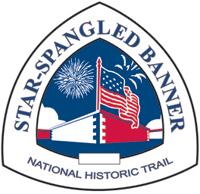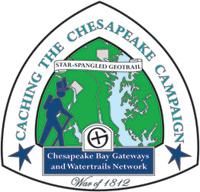During the first challenge along the Star-Spangled Banner GeoTrail, over 400 first edition SSB geocoins were awarded. We would like to thank everyone who participated in the Star-Spangled Banner GeoTour. We are currently out of geocoins but stay tuned for other opportunities along the Star-Spangled Banner GeoTour!


There is a grounds trail pass fee to use the hiking trails of $5.00 for adults and $3.00 for children. If you do not plan to tour the facility, please ask for the $5.00 hiking fee!
Other fees apply to tour the facilities.
Come on a journey to remember and commemorate the dramatic chain of events, people and places that led to the birth of our National Anthem.
The story of the Star-Spangled Banner was shaped by the events of the Chesapeake Campaign during the War of 1812. From February 1813 until February 1815, the Chesapeake Bay was the center of a fierce struggle between the British and Americans. Places and landscapes still exist today that provide a touchstone to the past. The trail traces events and related sites that figured prominently in the Chesapeake Campaign of the War of 1812 that have national significance, physical integrity, and the potential for contemporary recreation and interpretation.

This cache is hidden along the trails of the beautiful Stratford Hall Plantation. Once inside the park, the cache is located down the beach road. The gate to the beach road is open during normal business hours. If you attempt to hike to this cache from the gate at the beach road, be advised you will have a 1 mile + hike!
Please plan your visit during normal business hours and refer to the Stratford Hall website for updates. Hours: Normal visitor hours - daily from 9:30 a.m. to 4:00 p.m. March through September, open weekends during January and February. Please check the website www.stratfordhall.org for complete hours of operation.
There is a grounds pass fee to use the hiking trails of $5.00 for adults and $3.00 for children.
Other fees apply to tour the facilities.
Situated along the Potomac River in Westmoreland County, with Nomini Bay to the south and Pope’s Creek to the north, Stratford Hall Plantation (c. 1730) is best known as the birthplace of Robert E. Lee, a Confederate General during the Civil War. Other early residents included two signers of the Declaration of Independence, Richard Henry Lee and Francis Lightfoot Lee. The site is a National Historic Landmark.

During the War of 1812, the Northern Neck landscape surrounding Stratford Hall was dramatically affected by repeated British incursions. Numerous raiding parties used the region’s creeks as landing points, proceeding to burn and plunder farms and small communities. For example, on July 21, 1813, an estimated 300 British troops disembarked at Hollis Marsh on Nomini Bay just east of Stratford, making their way into the surrounding countryside in search of goods for plunder. Local militia forces attempted to fight back, but were badly outnumbered. The federal government sent a force of several hundred men to assist, but these reinforcements never made it past Fredricksburg, leaving defense of the Northern Neck almost entirely in the hands of area residents.
In mid-July 1814, a large British force anchored off as St. Clement’s Island on the Maryland side of the Potomac, almost directly across from Stratford. The impressive assemblage of armaments must have been terrifying for the poorly armed militia on both side of the river as it included an enormous ship of the line Albion (74 guns). On July 20, the British ceased their waiting and launched an attack against the Virginia militia that had been gathering as word of the fleet spread. Supported by the brig Thistle (20 guns), British marines traveled in on barges and landed at Nomini Creek near Stratford. During a fierce fight, Nomini Church burned and the silver plate belonging to the congregation was carried off. The next day, a force of 1,200 men moved on Westmoreland Court House at Montross. With little resistance from the militia, the invaders plundered the area and set fire to many homes, farms and buildings, devastating the countryside.
During this period (1813-1814) hundreds of enslaved African Americans living on the Northern Neck, especially in Westmoreland County, escaped to the British or to seek freedom on their own. In his recent article “Slave Flight in the Northern Neck,” historian Stuart Butler cites an American militiaman as estimating that at least one hundred enslaved people joined the British in 1813 from Westmoreland and Northumberland Counties alone. He also cites a Lieutenant James Scott of the Royal Navy, who recalled, “…canoes full of the runaways now constantly sought the protection of some of the squadron, and it is to be feared that many perished during the dark nights by drifting out to sea.” Once arrived, these men and women served as guides on land and on the water. In addition, the British trained a corps of African American marines on Tangier Island that would later see combat in multiple engagements.
During a visit to Stratford Hall today, walk along the impressive bluffs and imagine a British fleet sailing by on its way to Alexandria and Washington, D.C. The Plantation is still managed as a farm on 1,670 of its original acres so it will not be hard to set the scene. Visitors can tour the Great House, outbuildings and the Plantation grounds and gardens.

Thanks to Vaetanone for helping with this hide and the Maryland Geocaching Society for assisting with this project!